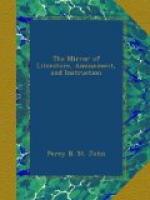W.G.C.
* * * * *
DESCRIPTION OF A BEAUTIFUL TREE.
By John F.M. Dovaston, Esq. A.M., of Westfelton, near Shrewsbury.
“Hamlet. Do you see
nothing there?
Queen. Nothing at all; yet all that is I
see.”
Hamlet.
“You cannot see the wood for
trees.”
Ray’s
Proverbs.
It was now the middle of May; the trees had fully put forth their bright, fresh leaves, and the green fields were luxuriant in a profusion of flowers. We had travelled through a fine country; when, descending the slope of a wooded valley, we were struck with delight and admiration at a tree of extraordinary appearance. There were several of the sort, dispersed singly, and in groups over the plains and grassy knolls. One we shall attempt to describe, though well aware how feeble is the most florid description to depict an idea of so magnificent an object. In height it exceeded 50 ft., the diameter of its shade was nearly 90 ft., and the circumference of the bole 15 ft.: it was in full leaf and flower, and in appearance at once united the features of strength, majesty, and beauty; having the stateliness of the oak, in its trunk and arms; the density of the sycamore, in its dark, deep, massy foliage; and the graceful featheriness of the ash, in its waving branches, that dangled in rich tresses almost to the ground. Its general character as a tree was rich and varied, nor were its parts less attractive by their extreme beauty when separately considered. Each leaf was about 18 in. in length; but nature, always attentive to elegance, to obviate heaviness, had at the end of a very strong leaf-stalk divided it into five, and sometimes seven, leafits, of unequal length, and very long oval shape, finely serrated. These leafits were disposed in a circular form, radiating from the centre, like the leaves of the fan palm, though placed in a contrary plane to those of that magnificent ornament of the tropical forests. The central, or lower, leafits were the largest, each of them being 10 in. in length, and 4 in. in breadth, and the whole exterior of the foliage being disposed in an imbricated form, having a beautifully light and palmated appearance. The flowers, in which the tree was profuse, demand our deep admiration and attention: each group of them rose perpendicularly from the end of the young shoot, and was in length 14 in., like a gigantic hyacinth, and quite as beautiful, spiked to a point, exhibiting a cone or pyramid of flowers, widely separate on all sides, and all expanded together, principally white, finely tinted with various colours, as red, pink, yellow, and buff, the stamina forming a most elegant fringe amid the modest tints of the large and copious petals. These feathery blossoms, lovely in colours and stately in shape, stood upright on every branch all over the tree, like flowery minarets on innumerable verdant turrets. We had thus the opportunity of ascertaining that it belonged to that class of Linnaeus consisting entirely of rare plants the Heptandria, and the order Monogynia; the natural order Trihilatae; and the A’cera of Jussieu.




